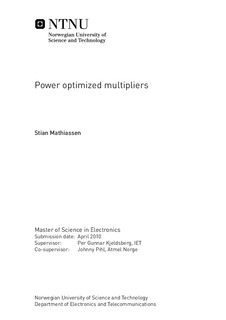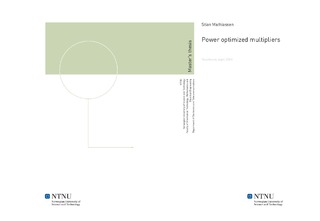| dc.description.abstract | Power consumption becomes more important as more devices becomes embedded or battery dependant. Multipliers are generally complex circuits, consuming a lot of energy. This thesis uses Sand's multiplier generator, made for his master thesis, as a basis. It uses tree structures to perform the multiplication, but does not take power consumption into account when generating a multiplier. By adding power optimization to the generator, multipliers with low energy consumption could be made automatically. This thesis adds different reduction tree algorithms (Wallace, Dadda and Reduced Area) to the program, and an optimal algorithm might be found. After the multiplier tree generation, an optimization step is performed, trying to exploit the delay and activity characteristics of the generated multiplier. A simplified version of Oskuii's algorithm is used. To be able to compare the different algorithms with each other, a pre-layout power estimation routine was implemented. The estimator is also used by the post-generation optimization. Since accuracy is important in an estimator, the delay through a multiplier was also investigated. Taking the previous mentioned steps into account, we are able to get a 10% decrease in overall power reduction in a 0,18/0,15um CMOS technology, reported by "IC Compiler". Delay characteristics of a multiplier is also supplied, and can be used by other power estimators. This thesis shows how to achieve less power consumption in multipliers. It also shows that the delay model is important for estimation purposes, and how an estimator is used to optimize a multiplier. The findings in this thesis can be used as is, or be used as a basis for further study. | nb_NO |

